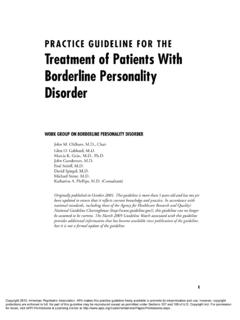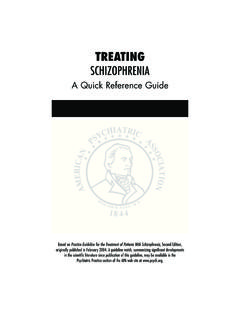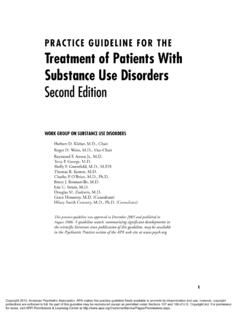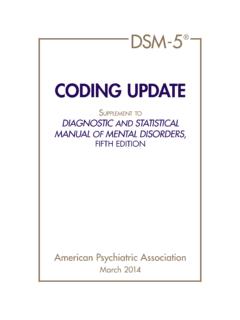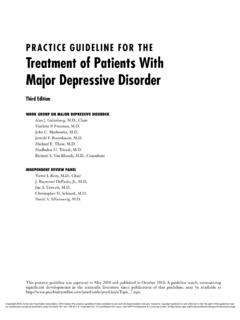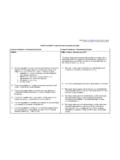Transcription of TREATING BORDERLINE PERSONALITY DISORDER
1 Based on Practice Guideline for the Treatment of Patients With BORDERLINE PERSONALITY DISORDER ,originally published in October 2001. A guideline watch, summarizing significant developments in thescientific literature since publication of this guideline, may be available in the Psychiatric Practice section of the APA web site at BORDERLINE PERSONALITY DISORDERA Quick Reference GuideAmerican Psychiatric Association Steering Committee on Practice GuidelinesJohn S. McIntyre, , ChairSara C. Charles, , Vice-ChairDaniel J. Anzia, A. Cook, T. Finnerty, R. Johnson, E. Nininger, Summergrad, M. Woods, , Yager, and Component LiaisonsRobert Pyles, (Area I)C. Deborah Cross, (Area II)Roger Peele, (Area III)Daniel J.
2 Anzia, (Area IV)John P. D. Shemo, (Area V)Lawrence Lurie, (Area VI)R. Dale Walker, (Area VII)Mary Ann Barnovitz, Hafter Gray, Saxena, Tonnu, Editors, Quick Reference GuidesMichael B. First, J. Fochtmann, Kunkle, , Senior Program ManagerAmy B. Albert, , Assistant Project ManagerClaudia Hart, Director, Department of Quality Improvement and Psychiatric ServicesDarrel A. Regier, , , Director, Division of ResearchStatement of IntentThe Practice Guidelines and the Quick Reference Guides are not intended to beconstrued or to serve as a standard of medical care. Standards of medical care aredetermined on the basis of all clinical data available for an individual patient andare subject to change as scientific knowledge and technology advance and practicepatterns evolve.
3 These parameters of practice should be considered guidelines to them will not ensure a successful outcome for every individual, norshould they be interpreted as including all proper methods of care or excludingother acceptable methods of care aimed at the same results. The ultimate judg-ment regarding a particular clinical procedure or treatment plan must be made bythe psychiatrist in light of the clinical data presented by the patient and the diag-nostic and treatment options development of the APA Practice Guidelines and Quick Reference Guideshas not been financially supported by any commercial organization. For moredetail, see APA s Practice Guideline Development Process, available as an appen-dix to the compendium of APA practice guidelines, published by APPI, and onlineat PsychiatricManagement Respond to crises andmonitor the patient s Establish and maintain a therapeutic frameworkand alliance.
4 260 Collaborate with thepatient in solving practical problems, giving advice and guidance when needed ..260 Provide education aboutborderline PERSONALITY DISORDER and its treatment ..260 Coordinate treatment provided by multiple clinicians ..261 Monitor and reassess thepatient s clinical statusand treatment plan ..261 Periodically considerarranging for a consul-tation if there is noimprovement during treatment..262 Be aware of and managepotential splitting andboundary problems .. ManagementIssues1. General Considerations ..2742. Anger, Impulsivity, and Violence ..2754. Potential Boundary Violations ..275 TREATINGBORDERLINE PERSONALITY Presentation1. Initial Assessment to Determine Treatment Setting.
5 2572. Comprehensive Evaluation ..2583. Treatment Framework .. ofTreatment Selection1. Type of Treatment ..2632. Flexibility andComprehensivenessof the Treatment Plan ..2633. Role of Patient Preference ..2634. Single Versus Multiple Clinicians .. TreatmentStrategies1. Individual PsychotherapeuticApproaches ..2642. Other Forms Pharmacotherapy and Other Somatic Treatments .. FeaturesInfluencing Treatment ..272 TREATINGBORDERLINE PERSONALITY DISORDER 257A. Initial Presentation1. Initial Assessment to Determine Treatment SettingConsider partial hospitalization(or brief inpatient hospitalization ifpartial hospitalization is not available) if any of the following arepresent: Dangerous impulsive behavior that cannot be managed withoutpatient treatment Deteriorating clinical picture related to nonadherence to outpatienttreatment Complex comorbidity that requires more intensive clinicalassessment of treatment response Symptoms that are unresponsive to outpatient treatment and thatare of sufficient severity to interfere with work, family life, or othersignificant domains of functioningConsider brief inpatient hospitalizationif any of the following arepresent.
6 Imminent danger to others Loss of control of suicidal impulses or serious suicide attempt Transient psychotic episode associated with loss of impulse control,impaired judgment, or both Symptoms that are unresponsive to outpatient treatment and partialhospitalization and that are of sufficient severity to interfere withwork, family life, or other significant domains of functioning TREATINGBORDERLINE PERSONALITY DISORDER2581. Initial Assessment to Determine Treatment Setting (continued)Consider extended inpatient hospitalizationif any of the followingare present: Persistent, severe suicidality or self-destructiveness Nonadherence to outpatient or partial hospital treatment Comorbid refractory axis I DISORDER ( , eating DISORDER , mooddisorder) that is potentially life threatening Comorbid substance dependence or abuse that is severe andunresponsive to outpatient treatment or partial hospitalization Continued risk of assaultive behavior toward others despite briefhospitalization Symptoms of sufficient severity to interfere with functioning andwork or family life and that are unresponsive to outpatienttreatment and partial hospitalization or brief hospitalization2.
7 Comprehensive EvaluationFollow initial assessment with a more comprehensive evaluation thatconsiders a wide range of domains and issues, including Presence of comorbid disorders Degree and types of functional impairment Intrapsychic conflicts and defenses Developmental progress and arrests Adaptive and maladaptive coping styles Psychosocial stressors and strengths in the face of stressors(See also APA s Practice Guideline for Psychiatric Evaluation ofAdults.)Consider additional sources of information ( , medical records,informants who know the patient well) in the assessment processbecause of patient denial and the ego-syntonicity of PERSONALITY traitsand PERSONALITY DISORDER 2593.
8 Treatment FrameworkEstablish a clear treatment framework ( , a treatment contract)with explicit agreements about the following: Goals of treatment sessions ( , symptom reduction, personalgrowth, improvement in functioning) When, where, and with what frequency sessions will be held A plan for crises Clarification of the clinician s after-hours availability Fees, billing, and paymentB. Psychiatric ManagementRespond to crises and monitor the patient s safety. Evaluate self-injurious or suicidal ideas. Assess the potential dangerousness of behaviors, the patient smotivations, and the extent to which the patient can manage his orher safety without external interventions. Reformulate the treatment plan as appropriate.
9 Consider hospitalization if the patient s safety is judged to be atserious primary treatment for BORDERLINE PERSONALITY DISORDER ispsychotherapy, which may be complemented by symptom-targetedpharmacotherapy. Throughout the course of treatment, it is important toprovide psychiatric management as follows: TREATINGBORDERLINE PERSONALITY DISORDER260B. Psychiatric Management (continued)Establish and maintain a therapeutic framework and alliance. Recognize that patients with BORDERLINE PERSONALITY DISORDER havedifficulty developing and sustaining trusting relationships. Ascertain that the patient agrees with and explicitly accepts thetreatment plan. Establish and reinforce an understanding about respective rolesand responsibilities regarding the attainment of treatment goals.
10 Encourage patients to be actively engaged in the treatment, both intheir tasks ( , monitoring medication effects or noting andreflecting on their feelings) and in the relationship ( , disclosingreactions to or wishes toward the clinician). Focus attention on whether the patient understands and acceptswhat the psychiatrist says, and whether the patient feels understoodand with the patient in solving practical problems, givingadvice and guidance when education about BORDERLINE PERSONALITY DISORDER and itstreatment. Familiarize the patient with the diagnosis, including its expectedcourse, responsiveness to treatment, and, when appropriate,known pathogenic factors. Provide ongoing education about self-care ( , safe sex, potentiallegal problems, sleep, and diet) if appropriate.



